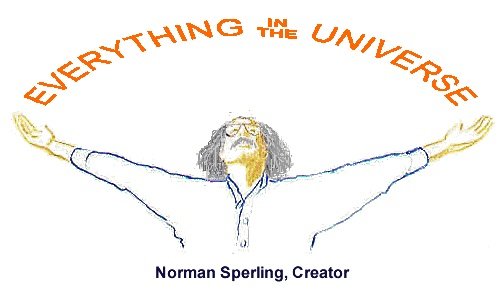I was interviewed about Astroscans, and a little about my wood-bound Dobsonian book, for the Astronomy Garage podcast by John Dreese. 1h 37m!
https://youtu.be/7WXJMSK3F1c
- — < ◊ > — -
—> Formatted for desktop screens; server scrambles segments for mobile devices. <—
Smarts and smiles! This website rewards time and thought. Not for “tl;dr” simpletons. Suckers seeking instant oversimplifications should retreat back to the rest of the Internet. No app, no loyalty bribe. No “artificial intelligence hallucinations” — everything here is by and for real humans.
Email: normsperling@gmail.com Postal: 2625 Alcatraz Avenue #235, Berkeley, California 94705 USA.
- — < ◊ > — -
NEW CHART UNIFIES STARS AND SOLAR SYSTEM
All Cosmic Bodies™,
From Meteorites to Stars,
Are Actually Cousins
© 2024 Norman Sperling
For the first time, you can understand the Solar System as a family of cousins, not a sideshow of freaks.
Space Age research reveals that stars, planets, moons, asteroids, comets, and meteorites each clumped from a cold nebula … heated … stirred … and banged around. Each clump’s mass determined how hot it got; closeness to the Sun helped. Each clump’s peak core temperature determined what processes it went through, its inside and surface structure, and how it looks now. Mass + Heat → Destiny.
Novel breakthrough! Graphing mass versus heat reveals sensible relationships and categories, which I color-coded. I converted mass measurements from “Earths” and “Suns” to kilograms. I sought best estimates of core temperature, since that’s not yet measured directly.
From least massive to most:
Purple: Chips land on Earth as meteorites.
Blue: Comets have surface ices, no matter what’s beneath.
Orange: Asteroids and small moons hold uneven shapes.
Green: Solid spheres pull themselves round.
Yellow [brown in the paper pasteup placeholder]: Substars can’t fuse hydrogen.
Red: but Stars do.
The antique term “planets” overlaps the largest solid spheres and the smallest substars.
Pictured: Paper pasteup placeholder. Artwork in progress.
This colorful graph will come in 2 versions:
• A free single-page download .pdf, 978-0913399-41-5
• And a glorious 24 x 36-inch poster, almost 10 times bigger, with thrilling photos of the bodies in space, and telling richer explanations and background. 978-0913399-42-2. Buy the enriched poster version soon.
Great for the science-literate public, especially astronomers, educators, hobbyists, past and present astronomy students, planetaria, model solar systems, and more.
Advantages Over Antiquated Heritage Categories
SINGLE POSTER
PAGE
✅ Free
✅ ✅ Plots all bodies on the same scales
✅ ✅ Unifies everything to the Metric System
✅ ✅ Mass and temperature mark off categories
✅ ✅ Color coded classes: stars are red, ices are blue
✅ ✅ Doesn’t force gases and solids into the same category
✅ ✅ Plain-English concepts evade technical terms
✅ ✅ Shows that layering by density is a major process
✅ ✅ Clarifies most meteorites as fragments of asteroids
✅ Glorious images of heavenly bodies
✅ Exposes Heritage categories’ flimsy standards
✅ Enriched explanations
✅ Shows that heat and pressure strengthen solids
✅ Nature’s narrow criteria for volcanoes and tectonics
✅ Chart: where elements come from
Advantages Over the Hertzsprung-Russell Diagram
✅ ✅ Stars relate to planets, comets, asteroids
✅ ✅ Temperature increases to the right, not the left
✅ ✅ Core temperature is more important than surface’s
✅ ✅ Mass is much more fundamental than luminosity
✅ ✅ Undistracted by “magnitude’s” backward 5th-root-of-100 ratio
✅ ✅ Stars evolve straight right, not helter-skelter
points to ✅ Where neutron stars fit
The Free Single-Page version will be a downloadable .pdf. We invite and permit people who do, teach, study, communicate, or facilitate Science to copy that version for free, if credited to “© 2024 Norman Sperling, EverythingInTheUniverse.com. All rights reserved.” All other users and uses: request from normsperling@gmail.com.


